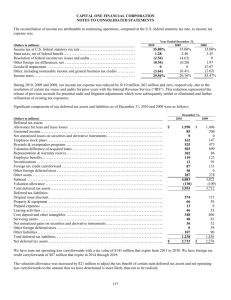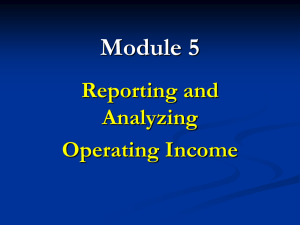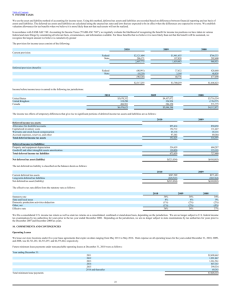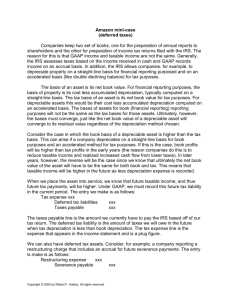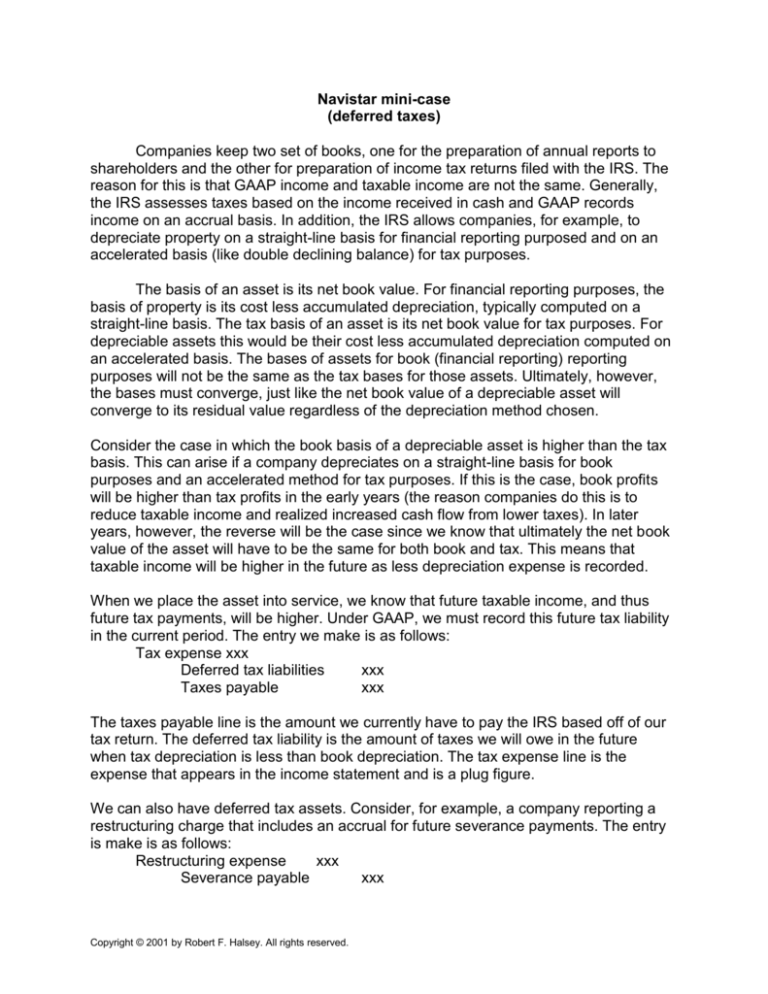
Navistar mini-case
(deferred taxes)
Companies keep two set of books, one for the preparation of annual reports to
shareholders and the other for preparation of income tax returns filed with the IRS. The
reason for this is that GAAP income and taxable income are not the same. Generally,
the IRS assesses taxes based on the income received in cash and GAAP records
income on an accrual basis. In addition, the IRS allows companies, for example, to
depreciate property on a straight-line basis for financial reporting purposed and on an
accelerated basis (like double declining balance) for tax purposes.
The basis of an asset is its net book value. For financial reporting purposes, the
basis of property is its cost less accumulated depreciation, typically computed on a
straight-line basis. The tax basis of an asset is its net book value for tax purposes. For
depreciable assets this would be their cost less accumulated depreciation computed on
an accelerated basis. The bases of assets for book (financial reporting) reporting
purposes will not be the same as the tax bases for those assets. Ultimately, however,
the bases must converge, just like the net book value of a depreciable asset will
converge to its residual value regardless of the depreciation method chosen.
Consider the case in which the book basis of a depreciable asset is higher than the tax
basis. This can arise if a company depreciates on a straight-line basis for book
purposes and an accelerated method for tax purposes. If this is the case, book profits
will be higher than tax profits in the early years (the reason companies do this is to
reduce taxable income and realized increased cash flow from lower taxes). In later
years, however, the reverse will be the case since we know that ultimately the net book
value of the asset will have to be the same for both book and tax. This means that
taxable income will be higher in the future as less depreciation expense is recorded.
When we place the asset into service, we know that future taxable income, and thus
future tax payments, will be higher. Under GAAP, we must record this future tax liability
in the current period. The entry we make is as follows:
Tax expense xxx
Deferred tax liabilities
xxx
Taxes payable
xxx
The taxes payable line is the amount we currently have to pay the IRS based off of our
tax return. The deferred tax liability is the amount of taxes we will owe in the future
when tax depreciation is less than book depreciation. The tax expense line is the
expense that appears in the income statement and is a plug figure.
We can also have deferred tax assets. Consider, for example, a company reporting a
restructuring charge that includes an accrual for future severance payments. The entry
is make is as follows:
Restructuring expense
xxx
Severance payable
xxx
Copyright © 2001 by Robert F. Halsey. All rights reserved.
The company, thus, reports the expense for book purposes currently when the liability is
incurred. For tax purposes, however, the expense is not a deduction until the severance
payments are actually paid. In this case, book income is less than tax income. We
know, however, that we will have a future deduction when the payments are made. This
is a future tax benefit and meets the test of an asset. So, we record a deferred tax
asset. Deferred tax assets reduce current the tax expense reported for book purposes
with the following entry:
Tax expense
xxx
Deferred tax asset xxx
Tax payable
xxx
Companies can have both deferred tax assets and deferred tax liabilities. The amount
of expense reported in the company’s income statement will depend on 1. the amount
of tax payable (current portion) and the changes in deterred tax assets and liabilities
(deferred portion). This mini-case is designed to give you an introduction into deferred
taxes. We will use the Navistar International annual report for this exercise, portions of
which follow. Please answer the following questions:
1. How much income tax expense did the company report for 2000? Of this
amount, how much is currently payable and how much is due to changes in
deferred tax assets and liabilities?
2. What deferred tax assets and liabilities does the company report in total? Are
the assets and liabilities reported separately or netted on the balance sheet?
3. What are the major categories of deferred tax assets and liabilities? How might
these arise?
4. The company reports net operating loss carry forwards. Generally, these relate
to taxable losses that, under the IRS code, can be carried forward to future
years to reduce taxable income in those years. If it is unlikely that the NOL’s will
be used before they expire, the company must set up a valuation allowance to
reduce the deferred tax asset, just like the allowance for doubtful accounts.
What will be the effect on current profitability if a company establishes a deferred
tax asset valuation allowance?
5. What changes does Navistar International report in its deferred tax valuation
allowance account for 2000? Describe what prompted the change and the effect
the change had on its reported income?
6. As an analyst, how should you view deferred tax asset valuation accounts?
Copyright © 2001 by Robert F. Halsey. All rights reserved.
STATEMENT OF FINANCIAL CONDITION
Navistar International Corporation
and Consolidated Subsidiaries
---------------------------------As of October 31
Millions of dollars
2000
1999
ASSETS
Current assets
Cash and cash equivalents ............................
Marketable securities ................................
Receivables, net .....................................
Inventories ..........................................
Deferred tax asset, net ..............................
Other assets .........................................
$
297
167
1,075
648
198
82
-----
$
243
138
1,550
625
229
57
-----
Total current assets ......................................
2,467
2,842
Marketable securities .....................................
Finance and other receivables, net ........................
Property and equipment, net ...............................
Investments and other assets ..............................
Prepaid and intangible pension assets .....................
Deferred tax asset, net ...................................
37
1,467
1,779
234
297
664
-----
195
1,268
1,475
207
274
667
-----
Total assets ..............................................
$ 6,945
=====
$ 6,928
=====
$
$
LIABILITIES AND SHAREOWNERS' EQUITY
Liabilities
Current liabilities
Notes payable and current maturities of long-term debt
Accounts payable, principally trade ..................
Other liabilities ....................................
482
1,096
831
-----
192
1,399
911
-----
Total current liabilities .................................
2,409
2,502
Debt:
Manufacturing operations ...........................
Financial services operations ......................
Postretirement benefits liability .........................
Other liabilities .........................................
437
1,711
660
414
-----
445
1,630
634
426
-----
Total liabilities ................................
5,631
-----
5,637
-----
4
4
Commitments and contingencies
Shareowners' equity
Series D convertible junior preference stock ..............
Common stock
Copyright © 2001 by Robert F. Halsey. All rights reserved.
(75.3 million shares issued) .........................
Retained earnings (deficit) ...............................
Accumulated other comprehensive loss ......................
Common stock held in treasury, at cost
(15.9 million and 12.1 million shares held) ..........
2,139
(143)
(177)
2,139
(297)
(197)
(509)
-----
(358)
-----
Total shareowners' equity ........................
1,314
-----
1,291
-----
Total liabilities and shareowners' equity .................
$ 6,945
=====
$ 6,928
=====
Copyright © 2001 by Robert F. Halsey. All rights reserved.
STATEMENT OF INCOME
Navistar International Corporation
and Consolidated Subsidiaries
-----------------------------------------------------For the Years Ended October 31
Millions of dollars, except share data
Sales and revenues
Sales of manufactured products.................................
Finance and insurance revenue..................................
Other income...................................................
2000
$
Total sales and revenues..................................
Costs and expenses
Cost of products and services sold.............................
Cost of products sold related to restructuring.................
8,119
288
44
----8,451
-----
1999
$
8,326
256
60
----8,642
-----
1998
$
7,629
201
55
----7,885
-----
6,774
20
----6,794
286
146
280
488
146
87
----8,227
-----
6,862
----6,862
216
281
486
135
71
----8,051
-----
6,498
----6,498
174
192
427
105
79
----7,475
-----
Income before income taxes............................
Income tax expense....................................
224
65
-----
591
47
-----
410
111
-----
Net income.....................................................
159
544
299
Less dividends on Series G preferred stock.....................
----159
=====
----544
=====
11
----288
=====
Total cost of products and services sold..................
Restructuring and loss on anticipated sale of business.........
Postretirement benefits........................................
Engineering and research expense...............................
Sales, general and administrative expense......................
Interest expense...............................................
Other expense..................................................
Total costs and expenses..................................
Net income applicable to common stock..........................
Copyright © 2001 by Robert F. Halsey. All rights reserved.
$
$
$
3.
INCOME TAXES
The domestic and foreign components of income before income taxes consist
of the following:
Millions of dollars
2000
1999
1998
- -------------------------------------------------------------------------------Domestic ..........................
Foreign ...........................
$ 145
79
-----
$ 489
102
-----
$ 403
7
-----
Total income before income taxes ..
$ 224
=====
$ 591
=====
$ 410
=====
The components of income tax expense consist of the following:
Millions of dollars
2000
1999
1998
- -------------------------------------------------------------------------------Current:
Federal .......................
State and local ...............
Foreign .......................
$
4
4
21
-----
$
11
4
25
-----
$
29
-----
40
-----
7
-----
38
7
11
-----
154
23
8
-----
127
19
3
-----
Total deferred expense ................
56
-----
185
-----
149
-----
Less research and development credit ..
Less valuation allowance adjustment ....
(20)
------
-(178)
-----
-(45)
-----
Total current expense .................
Deferred:
Federal .......................
State and local ...............
Foreign .......................
Total income tax expense ..............
$
65
=====
$
47
=====
4
3
------
$
111
=====
The deferred tax expense does not represent cash payment of income taxes
and was primarily generated by the utilization of net operating loss (NOL)
carryforwards and the increase of temporary differences, and will not require
future cash payments. Consolidated tax payments made during 2000, 1999 and 1998
were $29 million, $40 million and $7 million, respectively.
The relationship of the tax expense to income before taxes for 2000, 1999
and 1998 differs from the U.S. statutory rate (35%) because of state income
taxes and the benefit of NOL carryforwards in foreign countries. The 2000
effective tax rate reflects a $20 million research and development tax credit.
Also, the 1999 and 1998 effective tax rates reflect a $178 million and $45
million reduction in the deferred tax asset valuation allowance, respectively. A
valuation allowance has been provided for those NOL carryforwards and temporary
Copyright © 2001 by Robert F. Halsey. All rights reserved.
differences, which are estimated to expire before
effective tax rates for 2000, 1999 and 1998 were
respectively.
they are utilized. The
29.0%, 8.0% and 27.0%,
In the third quarter of 2000, the company completed a study of research and
development activities that occurred over the last several years and recorded
$20 million of research and development tax credits. These credits will be taken
against future income tax payments. During 1999, as a result of continued strong
industry demand, the continued successful implementation of the company's
manufacturing strategies, changes in the company's operating structure, and
other positive operating indicators, management reviewed its projected future
taxable income and evaluated the impact of these changes on its deferred tax
asset valuation allowance. This review resulted in a reduction to the deferred
tax asset valuation allowance of $178 million, which reduced income tax expense
during the third quarter of 1999. In addition, a $45 million reduction in the
valuation allowance was recorded during the fourth quarter of 1998 based on a
similar review.
Undistributed earnings of foreign subsidiaries were $171 million and $126
million at October 31, 2000 and 1999, respectively. Taxes have not been provided
on these earnings because no withholding taxes are applicable upon repatriation
and any U.S. tax would be substantially offset by the utilization of NOL
carryforwards.
Taxpaying entities of the company offset all deferred tax assets and
liabilities within each tax jurisdiction. The components of the deferred tax
asset (liability) at October 31 are as follows:
Millions of dollars
Deferred tax assets:
Net operating loss carryforwards...........................................
Alternative minimum tax and research and development credits...............
Postretirement benefits....................................................
Product liability and warranty.............................................
Employee incentive programs................................................
Restructuring costs........................................................
Other liabilities..........................................................
2000
$
Total deferred tax assets..................................................
Deferred tax liabilities:
Prepaid pension assets.....................................................
Depreciation...............................................................
Total deferred tax liabilities.............................................
Total deferred tax assets..................................................
Less valuation allowance...................................................
Net deferred U.S. tax assets...............................................
Copyright © 2001 by Robert F. Halsey. All rights reserved.
$
308
60
266
104
25
81
135
----979
-----
1999
$
397
35
266
116
77
129
----1,020
-----
(92)
(16)
----(108)
-----
(102)
(22)
----(124)
-----
871
(65)
----806
-----
896
(65)
----831
-----
$
At October 31, 2000, the company had $863 million of domestic and $87
million of foreign NOL carryforwards available to offset future taxable income.
Such carryforwards reflect income tax losses incurred which will expire as
follows, in millions of dollars:
2008......................................... $
2009.........................................
2011.........................................
Indefinite...................................
710
20
179
41
----
Total........................................ $
950
====
Additionally, the reversal of net temporary differences of $1,318 million
as of October 31, 2000 will create net tax deductions, which, if not utilized
previously, will expire subsequent to 2011.
Copyright © 2001 by Robert F. Halsey. All rights reserved.

